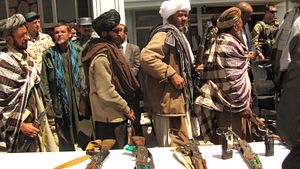Since the revelation of the death of Mullah Omar in 2015, the Taliban has disintegrated into multiple factions, at times even warring against each other. The selection of Mullah Mansour as supreme leader after Omar’s death failed to heal rifts within the organization, and his sudden death in a U.S. drone strike in May has only added to the Taliban’s existential crisis.
Various Taliban field commanders, disgruntled with the disarray of the Taliban and battlefield setbacks, have flocked to competing groups such as Islamic State (ISIS) and al-Qaeda, adding to the ever-confusing battlefield landscape that is Afghanistan.
Faced with a potential recruitment shortage and further splintering, former Taliban leaders such as Agha Jan Motasim, a former Taliban minister, and Sayed Muhammad Tayeb Agha, the former Taliban chief negotiator, have called on Haibatalluah Akhundzada, Mansour’s replacement as Taliban supreme leader, to negotiate with the Afghan government and implement reforms in the movement.
Afghan President Ashraf Ghani’s administration has sought to sow dissent and further factionalism within the resurgent militant group, even providing arms, training, and security support to one of the disaffected factions under the command of Mullah Mohammad Rassoul Noorzai, a prominent battlefield commander from Zabul. Attempting to bandwagon splinter groups, Ghani’s administration seeks to pressure misaligned groups operating in Afghanistan’s rural countryside. The hope is to convince various factions that if they don’t join the peace process, their piece of any reconciliation or financial aid will get ever smaller.
With major gains in the rural countryside by Taliban militants coupled with the failure to capture any major population centers, any future gains by the militant group will come at ever-increasing costs in the form of man power and resources. The Taliban are slowly approaching a precipice of diminishing returns on continuing their insurgency, when costs will far outpace minimal land grabs or momentary headline-grabbing operations. The time to negotiate is now.
However, any agreement reached will have to be reconciled with field commanders, and the implementation of any ceasefire can only be maintained with the support of Taliban commanders. Three Taliban negotiators, Mullah Shahabuddin Dilawar, Mullah Jan Mohammad Madani, and Mullah Abdul Salam Hanafi, highlighted this conundrum to Pakistani officials in October when they visited to brief government officials regarding the peace talks in Doha. “Taliban military commanders and fighters hold the key to continuing or ending the war,” they said, and reaching those commanders will prove exceedingly difficult as the militant organization is currently waging war in 34 provinces.
How much clout the political wing of the Taliban in Quetta has over field commanders is unknown. The ability to foster any agreement will rely heavily on the Taliban to showcase its ability to rein in its commanders at a time when factionalism and disaffected groups and fighters are still rampant within the organization.

































